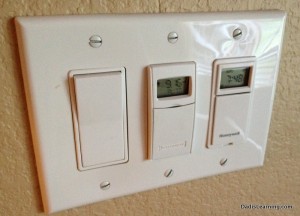How Much Does It Cost To Leave the Lights On?
 The other night I was so tired that the moment by body got somewhat horizontal I was out cold. There was a problem though, I hadn’t gone through the night time routine of turning off all the lights and double-checking all the doors. That got me to thinking about how much does it cost to leave the lights on. Just like you, I was always taught to turn the lights off when I leave a room. And just like you, I sometimes forget. In today’s post I explore just how much it is costing us when we leave the lights on.
The other night I was so tired that the moment by body got somewhat horizontal I was out cold. There was a problem though, I hadn’t gone through the night time routine of turning off all the lights and double-checking all the doors. That got me to thinking about how much does it cost to leave the lights on. Just like you, I was always taught to turn the lights off when I leave a room. And just like you, I sometimes forget. In today’s post I explore just how much it is costing us when we leave the lights on.
Determining Wattage and Usage
I went around the house adding up the wattage of all the lights that we typically use, skipping all the rarely used lights. The total wattage of our lighting amazed me…just over 3,000 watts! The wattage numbers on lights are an estimate of the hourly electricity consumption for that bulb. We have been working on replacing our larger incandescent bulbs with compact fluorescent bulbs (CFL). Here is a quick breakdown of our wattage:  The numbers were easy to work with. I totaled the wattage of the bulbs in each room and then divided that by 1,000 to get that number into kilowatts. I then multiplied that number by the number of hours the lights were on and finally by our $0.09 per kilowatt hour electricity rate. On the average day we spend about $1.35 lighting our house.
The numbers were easy to work with. I totaled the wattage of the bulbs in each room and then divided that by 1,000 to get that number into kilowatts. I then multiplied that number by the number of hours the lights were on and finally by our $0.09 per kilowatt hour electricity rate. On the average day we spend about $1.35 lighting our house.
Back to my original question… how much did it cost that night that I left the lights on. There was 1,062 watts worth of lighting left on. Let’s do the math:
((1,062 / 1,000) x 7 hours) x $0.09 = $0.67
Not the end of the end of the world for a simple mistake, but I would rather have saved my $0.67 by turning off the lights.
Observations
I was blown away by the amount of energy being used in our master bedroom. At 684 watts this room uses the most energy for lighting of any in our house. Here’s the reason, we haven’t switched the bulbs over to CFL yet. The main lighting in our bathroom is 2 sconces that have a total of (8) 40-watt incandescent bulbs. The lights in our bedroom area get left on more than they probably should since we are in and out of there all throughout the day. Let’s use this room as an example for CFL savings.
A quick search on Amazon found an 8 pack of GE 13 watt CFL bulbs (60 watt equivalent) at a cost of $10.99. That is $1.35 a bulb which is pretty good. There are 14 incandescent bulbs in our master bedroom area. Total cost for replacing all these bulbs would be approximately $17 and would shave 324 watts off of our consumption bringing the total for that area of the house from 684 watts to 360. The new average cost of lighting per day would be $0.13, a savings of $0.12 per day. The new CFL bulbs could potentially pay for themselves in 5 months and save us $43 per year in this one section of our house! (Yeah…I just clicked buy on Amazon.)
The new CFL bulbs will actually provide more light (or lumens) than our current incandescent bulbs. As part of my experiment and observations I plan to write the date of installation on the base of each CFL bulb. We have CFL bulbs in other parts of our home and I’ll be curious to see how long they last based on my usage estimates.
How much would it cost to replace all our incandescent bulbs with CFL bulbs? And what would be the estimated annual savings? We have (45) 40-watt incandescent bulbs in our house. Using the Amazon price, it will cost $61 to replace all of these bulbs. Total energy savings would be 1,215 watts. Total estimated savings would be 1,372 watts per day or $0.52 a day. Total annual savings could be $190, that’s well worth a $61 dollar investment.
Tips and a Change
I use switch timers for our outside lights. They are pretty easy to install in place of an existing switch and automatically turn the lights on and off at the set time. Make sure to get a switch that is approved for use with a CFL bulb. I have found timer switches to be more reliable than photocell lights that turn themselves on at dark and off at sunrise. Over time, most photocell lights wind up staying on during the day. I was impressed that our outside security lighting is only costing $0.13 a day. I consider this a good investment since the entire exterior of our home is lit.
Read the fine print on light bulb packaging carefully. The new CFL and LED bulbs claim lifespans of 10, 20 and sometimes even 25 years. This lifetime is based on 3 hours of use per day. Savings calculations can also be interesting. Calculations are based on the anticipated life of the bulb, in this case 10,000 hours. Potential savings were calculated at $70 which is accurate for the 10,000 hour period, but many consumers might think that this is annual potential savings. Most of these bulbs are only guaranteed for half of the expected lifespan of the bulb.
Finally, a lesson for our house. We leave some lights on in the kitchen in case our 5-year old needs to come find us in the night. I’m not sure why we started doing this. The fluorescent under-cabinet lighting that we leave on uses 109 watts and costs approximately $0.09 per night. (The bulbs and ballasts are also odd sizes and hard to replace so this is a bad idea.) We could easily use another light in our kitchen that only consumes 22 watts ($0.02 per night). Or we could use a $3 LED nightlight that consumes $0.25 of electricity annually. That’s an additional savings of $30 annually plus additional savings in replacement costs for the under-cabinet bulbs and ballasts.
Final Thoughts
For an investment of approximately $64 (45 CFL bulbs and 1 LED nightlight) we could save at least $225 a year in electricity costs. As anyone with a family knows, every little bit of savings helps! Of course simply turning off lights when they are not being used is the best way to save on the cost of lighting a home.
A previous Dad is Learning post was featured in Aspiring Blogger’s Personal Finance Carnival last week. There was a great collection of posts about various financial topics. Some of my favorites were: “The Importance of Date Night” by KidsAintCheap and “The Value of Time and Money” by MyMoneyDesign. I appreciate Aspiring Blogger including me in his listing of blogs and would appreciate you checking out his personal finance carnival using the link above.
My “How Much Does It Cost” series of posts are quickly becoming some of the most popular on the blog. Did you catch these?
- How Much Does It Cost To Mow the Lawn? – This post is generating a lot of search traffic every day. Lots of people are curious about the cost of mowing an acre of land.
- How Much Does It Cost To Water the Lawn? – If you’re going to mow it, you might as well keep it green. Some observations about watering and the costs involved.
Did today’s post get the gears turning in your head? I’d be curious to hear any thoughts or questions you have in the comments section below. Also, if you found this interesting I would appreciate you sharing this post using the buttons below. Thanks!


Hey Jon, thanks for the shout out! We just replaced all of our kitchen/master bathroom lights with CFLs. Other lights in the house are already CFL and the few that aren’t we don’t use very often, so I can’t make a compelling case for upgrading. I like how you broke it down though, great use of real data to make a decision!
AB
Pingback: How Much Does It Cost: Christmas Lights - Dad Is Learning